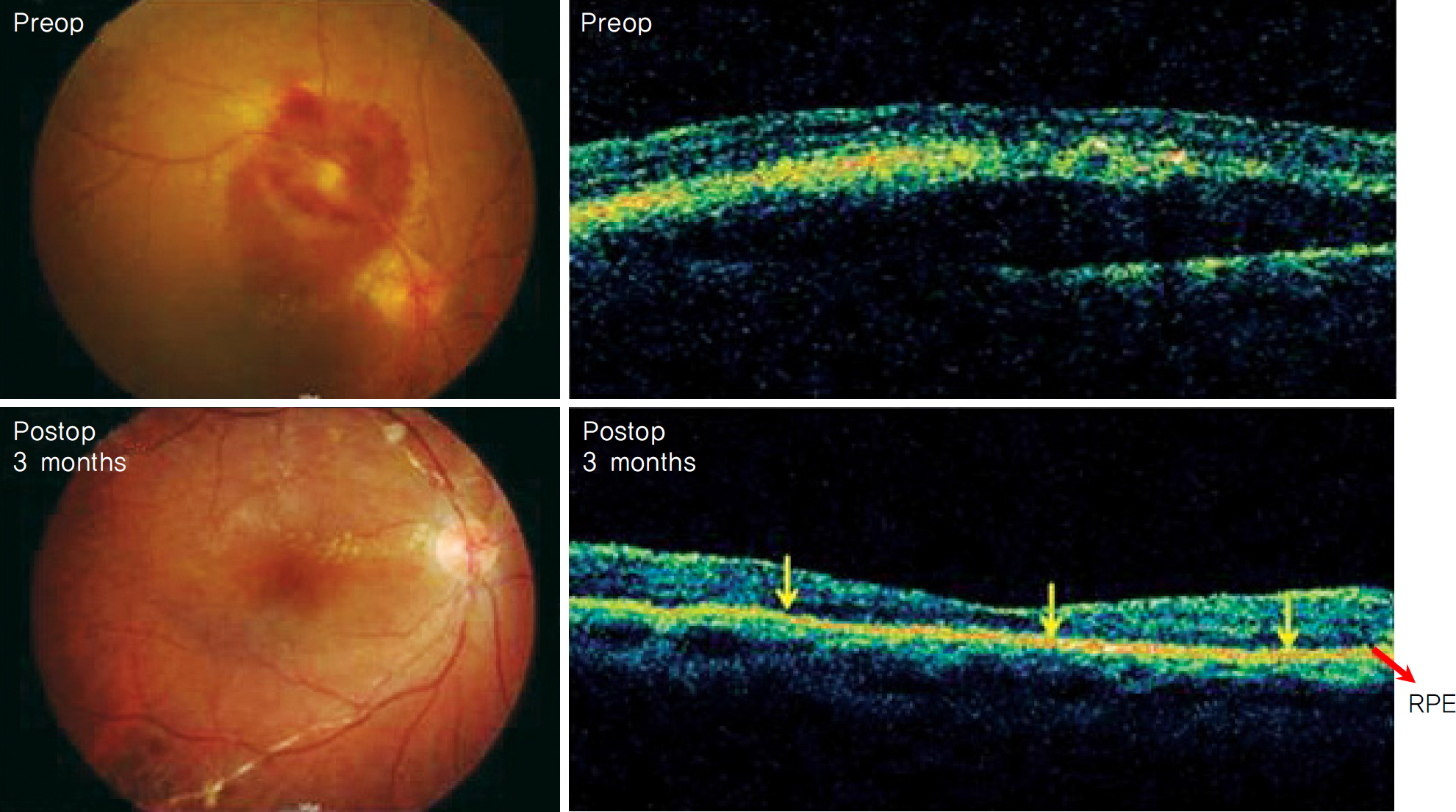J Korean Ophthalmol Soc.
2010 Jul;51(7):961-966. 10.3341/jkos.2010.51.7.961.
Clinical Results of Vitrectomy in Macular Hemorrhage From a Ruptured Retinal Artery Macroaneurysm
- Affiliations
-
- 1Department of Ophthalmology, Seoul National University College of Medicine, Seoul, Korea. hgonyu@snu.ac.kr
- 2Sensory organ research institute, Medical Research Center, Seoul National University, Seoul, Korea.
- KMID: 2213766
- DOI: http://doi.org/10.3341/jkos.2010.51.7.961
Abstract
- PURPOSE
To evaluate the relationship between postoperative optical coherence tomography (OCT) findings and visual acuity in patients who underwent vitrectomy for macular hemorrhage related to the rupture of a retinal artery macroaneurysm.
METHODS
A retrospective case review was conducted for patients who underwent vitrectomy for macular hemorrhage caused by a retinal arterial macroaneurysm. The relationship between postoperative OCT findings and visual acuity was analyzed.
RESULTS
This study included 12 patients whose preoperative mean best corrected visual acuity (BCVA) (logMAR) was 1.7+/-0.8 and whose mean final BCVA was 0.6+/-0.5. These values were statistically different (p=0.004). Mean foveal thickness by OCT was 437.5+/-161.5 micrometer at the preoperative period and 252.8+/-84.9 micrometer three months postoperative, and this difference was statistically significant (p=0.017). As the foveal thickness decreased after removal of the remnant organized retinal hemorrhage in the postoperative period, BCVA improved at the final follow-up (p=0.048). According to the postoperative OCT, the photoreceptor disruption group presented a lower BCVA than that of the photoreceptor preservation group at the final follow-up (logMAR: 1.4+/-0.4 vs. 0.3+/-0.2, p=0.009).
CONCLUSIONS
Photoreceptor preservation as observed by OCT was significantly associated with better visual outcome after vitrectomy in patients with macular hemorrhage caused by rupture of a retinal arterial macroaneurysm.
Keyword
MeSH Terms
Figure
Cited by 3 articles
-
Bevacizumab Monotherapy for Macular Hemorrhage Secondary to a Retinal Arterial Macroaneurysm
Ji Soo Kim, Ju Byung Chae, Jin Young Kim, Sung Min Hyung, Dong Yoon Kim
J Korean Ophthalmol Soc. 2019;60(4):323-330. doi: 10.3341/jkos.2019.60.4.323.Vitrectomy-Assisted Intravitreal Tissue Plasminogen Activator and SF6 Gas Injection on Submacular Hemorrhage
Min Uk Kim, Ji Won Lim
J Korean Ophthalmol Soc. 2010;51(11):1459-1463. doi: 10.3341/jkos.2010.51.11.1459.Ruptured Retinal Arterial Macroaneurysm after Panretinal Photocoagulation for Diabetic Retinopathy
Seon Tae Kim, Yoon Hyung Kwon
J Korean Ophthalmol Soc. 2017;58(5):606-610. doi: 10.3341/jkos.2017.58.5.606.
Reference
-
References
1. Asdourian GK, Goldberg MF, Jampol L, Rabb M. Retinal macro-aneurysms. Arch Ophthalmol. 1997; 95:624–8.
Article2. Nakamura H, Hayakawa K, Sawaguchi S, et al. Visual outcome after vitreous, sub-internal limiting membrane, and/or submacular hemorrhage removal associated with ruptured retinal arterial macroaneurysms. Graefes Arch Clin Exp Ophthalmol. 2008; 246:661–9.
Article3. Ibanez HE, Williams DF, Thomas MA, et al. Surgical management of submacular hemorrhage. A series of 47 consecutive cases. Arch Ophthalmol. 1995; 113:62–9.4. Moriarty AP, McAllister IL, Constable IJ. Initial clinical experience with tissue plasminogen activator (tPA) assisted removal of sub-macular haemorrhage. Eye. 1995; 9:582–8.
Article5. Lim JI, Drews-Botsch C, Sternberg P Jr, et al. Submacular hemorrhage removal. Ophthalmology. 1995; 102:1393–9.
Article6. Humayun M, Lewis H, Flynn HW Jr, et al. Management of sub-macular hemorrhage associated with retinal arterial macroaneurysms. Am J Ophthalmol. 1998; 126:358–61.
Article7. Peyman GA, Nelson NC Jr, Alturki W, et al. Tissue plasminogen acti-vating factor assisted removal of subretinal hemorrhage. Ophthalmic Surg. 1991; 22:575–82.
Article8. Lee HJ, Chung MR, Kim HC. Treatment of retinal arterial macro-aneurysm. J Korean Ophthalmol Soc. 2003; 44:2250–8.9. Sakamoto A, Nishijima K, Kita M, et al. Association between fo-veal photoreceptor status and visual acuity after resolution of diabetic macular edema by pars plana vitrectomy. Graefes Arch Clin Exp Ophthalmol. 2009; 247:1325–30.
Article10. Chang LK, Koizumi H, Spaide RF. Disruption of the photoreceptor inner segment-outer segment junction in eyes with macular holes. Retina. 2008; 28:969–75.
Article11. Suh MH, Seo JM, Park KH, Yu HG. Associations between macular findings by optical coherence tomography and visual outcomes after epiretinal membrane removal. Am J Ophthalmol. 2009; 147:473–80.
Article12. Rabb MF, Gagliano DA, Teske MP. Retinal arterial macroaneurysms. Surv Ophthalmol. 1988; 33:73–96.
Article13. Lavin MJ, Marsh RJ, Peart S, Rehman A. Retinal arterial macro-aneurysms: a retrospective study of 40 patients. Br J Ophthalmol. 1987; 71:817–25.
Article14. asZhao P, Hayashi H, Oshima K, et al. Vitrectomy for macular hemorrhage associated with retinal arterial macroaneurysm. Ophthalmology. 2000; 107:613–7.
Article15. Sayanagi K, Ikuno Y, Soga K, Tano Y. Photoreceptor inner and outer segment defects in myopic foveoschisis. Am J Ophthalmol. 2008; 145:902–8.
Article
- Full Text Links
- Actions
-
Cited
- CITED
-
- Close
- Share
- Similar articles
-
- Treatment of Retinal Arterial Macroaneurysm
- Macular Hole Formation Following Vitrectomy for Ruptured Retinal Arterial Macroaneurysm
- Full Thickness Macular Hole formation following Rupture of Retinal Arterial Macoraneur
- Ruptured Retinal Arterial Macroaneurysm after Panretinal Photocoagulation for Diabetic Retinopathy
- Bevacizumab Monotherapy for Macular Hemorrhage Secondary to a Retinal Arterial Macroaneurysm



